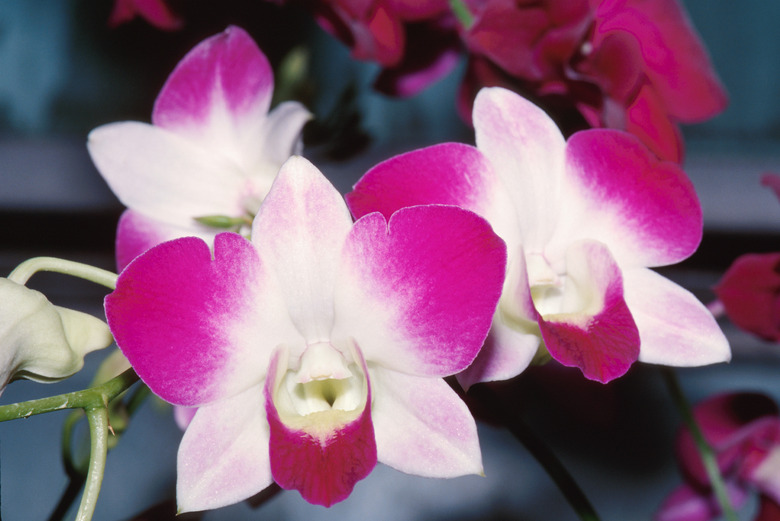How To Build A Shade House
Garden shade houses help prevent damage to plants during the bright days of summer and provide areas to grow special plants like orchids (Dendrobium spp.) perennials in U.S. Department of Agriculture plant hardiness zones 9 to 12.
Things Needed
- 15 10-foot pieces of 2-inch schedule 40 PVC pipe
- 6 2-inch press-fit tee fittings
- 8 three-way press-fit L fittings
- 31 linear feet of 20-foot-wide bulk 60 percent black shade cloth
- 32 snap clamps
- PVC cutter
- Sharp scissors
- Ladder
- Sandbags (optional)
- Grip clamps (optional)
Garden shade houses help prevent damage to plants during the bright days of summer and provide areas to grow special plants like orchids (Dendrobium spp.) perennials in U.S. Department of Agriculture plant hardiness zones 9 to 12. Shade cloth is the primary material used for the light-diffusing structures; each color or type is rated by the percentage of light it blocks. Use cloth suited to your growing conditions with a PVC-pipe framework to construct a practical shade house.
Build the Frame
Step 1
Cut six of the 10-foot lengths of PVC pipe in half to make 12 5-foot pieces. Cut down seven of the 10-foot pieces of PVC pipe to 8-foot pieces.
Step 2
Make a large square for your shade house base. Put a three-way L fitting on each end of a 10-foot length of PVC pipe. Join two 5-foot lengths of PVC pipe with a tee fitting to make a 10-foot section. Make two more 10-foot sections the same way.
- Garden shade houses help prevent damage to plants during the bright days of summer and provide areas to grow special plants like orchids (Dendrobium spp.)
- Join two 5-foot lengths of PVC pipe with a tee fitting to make a 10-foot section.
Step 3
Insert two of the 10-foot sections into the L fittings on the 10-foot piece at right angles to it. Put three-way L fittings onto the ends of the sections. Connect the sections to make the square base by inserting the third section between the L fittings. Repeat the directions to make the square for the top of the shade structure.
Step 4
Insert an 8-foot length of PVC pipe into each of the L and tee fittings on the shade house's top square. Turn the square over and insert the 8-foot sections into the fittings on the base. You now have a braced cube with one 8-by-10-foot opening in front.
- Insert two of the 10-foot sections into the L fittings on the 10-foot piece at right angles to it.
- Turn the square over and insert the 8-foot sections into the fittings on the base.
Cover the Frame
Step 1
Cut the last 3 feet off your shade cloth roll to make a 20-foot-wide-by-3-foot-long piece. Cut the piece into two 10-by-3-foot pieces.
Step 2
Lay your bulk shade cloth roll out next to the shade house. Ten feet of it will extend beyond the back edge. Unroll the bulk shade cloth and pull it up and over the shade house.
Step 3
Adjust the cloth so there is an even overhang on the sides. Make sure 10 feet extend beyond the back. Clamp the shade cloth to the frame starting at the top front and continuing along the top at the sides. Roll the bottom fabric under along the sides and clamp it to the base.
- Cut the last 3 feet off your shade cloth roll to make a 20-foot-wide-by-3-foot-long piece.
- Roll the bottom fabric under along the sides and clamp it to the base.
Step 4
Pull each end of the back material around toward the center back of the frame. Stretch it tightly and clamp at the frame top. Stretch and clamp the material to the frame bottom.
Step 5
Clamp the two 3-foot-wide-by-10-foot-long sections to the front of the shade house at the top. Leave a 4-foot opening for the door.
Secure the Structure
Step 1
Use sandbags on your foundation tubes to anchor the shade house in windy areas.
Step 2
Use bird netting instead of shade cloth for a double-duty enclosure that can protect berry bushes from marauders.
- Pull each end of the back material around toward the center back of the frame.
- Use sandbags on your foundation tubes to anchor the shade house in windy areas.
Step 3
Use grip clamps (aluminum clamps that go over snap clamps) for more secure fastening of your shade cloth.
Warning
You may need help stretching and clamping the shade fabric at the back of the shade house. If you will be gluing your shade house together permanently, dry-fit it and mark connections first to make sure all pieces are true and lengths are correct. Do not cut PVC pipe with a hacksaw because it causes burrs that impede the press fittings.
